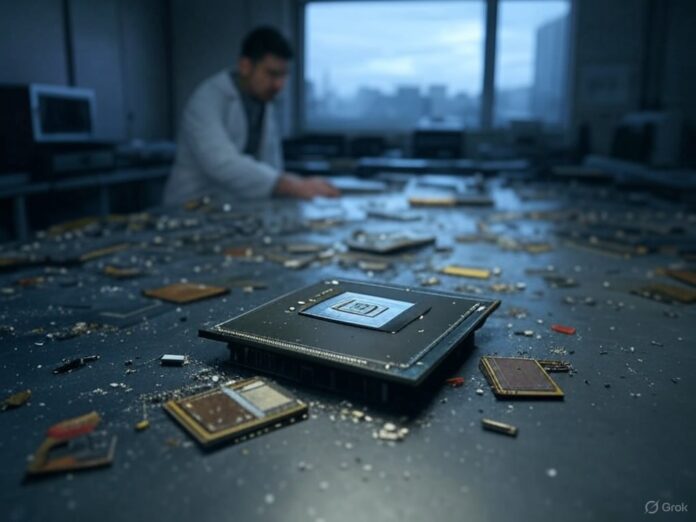The crisis Intel is facing has triggered an unusual phenomenon in the tech industry: a massive exodus of its top engineers to direct competitors, led by Samsung. The South Korean giant, which is seeking to consolidate its presence in the U.S. semiconductor market, is taking advantage of this exodus to recruit highly specialized profiles in technologies such as EUV lithography, advanced chip packaging, and backside power delivery to the substrate (BSPDN).
Intel is going through a turbulent period. Under the leadership of the current CEO, Ribu Tan, the company has announced an aggressive restructuring, with the cancellation of strategic projects and drastic cuts to its workforce. The stated objective is to reduce costs and redirect resources following what Tan himself described as 'an imprudent overinvestment' in production capacity over the last few years.
The adjustment plan contemplates the elimination of up to 75,000 jobs worldwide, a figure that reflects the magnitude of the crisis. Although a significant part of these cuts is concentrated in administrative and support areas, the talent drain has also reached key R&D teams. Engineers who had spent decades working on cutting-edge technologies are leaving the company, which is a hard blow to Intel's technological leadership.
The departure of Intel's elite engineers has not gone unnoticed in the industry. Samsung Electronics and Samsung Electro-Mechanics, with their divisions in the United States, have launched a talent recruitment drive. The objective is to reinforce areas in which the South Korean company still lacks the depth and experience that characterize Intel.
Among the most sought-after profiles are experts in next-generation semiconductor packaging, a field that is essential in the post‑Moore era, when shrinking transistor size is no longer enough to boost performance. Technologies such as EMIB (Embedded Multi-Die Interconnect Bridge) or glass substrates are considered strategic for the fabrication of more efficient and powerful chips.
In this context, Samsung has already managed to bring in well-known figures. One of the most talked-about signings is that of a veteran engineer specialized in EMIB, who has recently joined the company's foundry division. Another significant case is that of Gang Duan, until recently one of the leading figures responsible for advanced packaging at Intel, who has joined Samsung Electro-Mechanics in the United States to lead the technology marketing and applications engineering areas.
The movement reflects the fierce global competition in the semiconductor sector. While Intel struggles to regain its position after years of delays in its manufacturing nodes, Samsung and TSMC consolidate their leadership in advanced manufacturing. The recruitment of talent from Intel allows Samsung to accelerate its learning curve and close gaps in key areas of innovation.
The engineers from Intel bring not only technical knowledge, but also a consolidated culture of research in critical areas of microelectronics. For Samsung, which has massively invested in expanding its manufacturing capacity in the United States—with factories in Texas and plans for new facilities—this transfer of talent could make the difference against the competition.
However, not everything is optimism. There are voices within Samsung itself that call for caution. The company's executives acknowledge that it's not enough to hire for the sake of hiring: the challenge is to identify professionals who fit into specific projects and who can adapt to South Korea's corporate culture, historically more hierarchical and rigid than Silicon Valley's.
In fact, in recent years there have been cases of foreign engineers who left Samsung after only a few months of joining due to integration difficulties. The company knows that success does not depend solely on attracting talent, but also on retaining it.
The phenomenon occurs at a moment when geopolitics is conditioning the semiconductor industry like never before. The United States is pursuing its own strategy for technological sovereignty with the CHIPS and Science Act, which incentivizes domestic production and aims to reduce dependence on Asia. In this context, Samsung, which has benefited from aid for its plants on U.S. soil, needs to strengthen its local teams to meet production and development objectives.
Intel, for its part, is facing an existential dilemma. Although it remains a central player in the market, its ability to compete at the most advanced nodes has been questioned. If it fails to curb the talent hemorrhage, its disadvantage against rivals like Samsung or TSMC could become irreversible.
The brain drain from Intel to Samsung is more than just a corporate episode: it is a symptom of the profound transformation that the semiconductor industry is undergoing. Highly skilled talent has become a resource as strategic as the factories themselves. In a sector where development timelines are measured in decades and investments are counted in billions, the loss or gain of an engineering team can alter the global competitive balance.
Additionally, this dynamic introduces a human component into an industry typically described in numbers and silicon. Behind every restructuring decision there are professional careers, accumulated knowledge, and a struggle for survival in the most strategic market of the 21st century.
More information and references in Cloud News.



